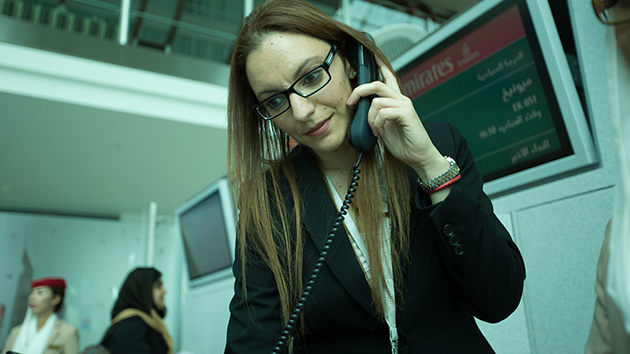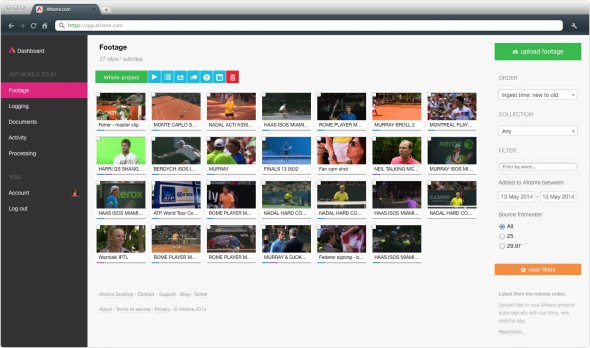Reducing Shooting and Improving Quality with a Proxy Workflow That Gets Footage to Edit Faster
Content creators are often skeptical about cloud storage for a number of reasons, bandwidth among them. Real-world connectivity issues make it hard to get high-quality footage into the cloud, especially from the kind of remote locations where cloud-based sharing with editorial would really come in handy. Still, there are smart ways to use the cloud. London's Arrow Media upped its game for the second season of Ultimate Airport Dubai, which it shot for National Geographic Channels International, by implementing a proxy-first workflow over Aframe's cloud platform that dramatically reduced the amount of footage shot and shaved the time spent in editing by about two weeks per one-hour program.
The production shot at Dubai International Airport using Sony PDW-750 XDCAM optical-disc camera systems. The low-res proxy files created in camera were uploaded to Aframe's cloud storage system for immediate retrieval by the editorial team back in London, which reviewed and logged the footage and provided instant feedback to the production. That might not sound like a big deal, but since Arrow had produced the first season, as well, it was able to make a direct comparison to see how much time was saved by implementing a proxy workflow. The results were compelling — the second season shot only about 60 percent as much footage as the first. And because the team got feedback faster from editorial, the footage was better.
Increasing Editorial Control
"For the first season, we shot 600 hours of material," recalls Nick Metcalf, executive producer for the show. "We wanted to get that total down. It's a lot of material for the editor to process, so we wanted to introduce much more editorial control."
Each 10-hour series of Ultimate Airport Dubai tells a number of stories about the airport's operations, with a half-dozen stories interwoven in each episode. That means the production needs to generate 60 stories over the course of the season. And it turns out that the team shooting doesn't always have the best perspective on its own footage, meaning that some of the stories that were thought to be in the can fizzled out when it was time to cut them together.
"We needed to get rushes back much more quickly than in season one," Metcalf says. "So we used Aframe's cloud-based digital storage system and we uploaded low-resolution proxies from the location. That was very helpful to us because Dubai, amazing place that it is, doesn't have brilliant Internet coverage. But we could send the proxies back pretty quickly, within a day or so of shooting, and start to assess the stories here in London.
"We had a dedicated team looking at stories and logging them and making instant assessments of whether they were good, bad, or indifferent, or missing a picture, or conclusion, or sound bite. We'd provide that feedback and, within days, get a repair if we needed it. It gave us a good handle on what was going on, and we could follow the progress with much more certainty than in season one. We could also assemble stories to a timeline with all of the elements we thought were needed that we could hand over to editorial when they started."
Saving 240 Hours of Shooting and 20 Weeks of Editing
The result, according to Metcalf, was tighter focus by the camera crews, who knew exactly what they needed to shoot, and better productivity in the edit. "Because of the editorial quality control, we got the amount of footage we shot [for the second season] down from 600 hours to 360 hours," he said. "And we got a better program. We went into the edit knowing what stories we had and knowing they were working, and we effectively saved ourselves about two weeks of editing per program — or 20 weeks total."
Post-production consultant Dan Carew-Jones was in charge of making sure the high-res files could be relinked when the original camera media eventually arrived in London. "Because the proxies are produced in camera, there's already a link back to the disc," he said. "We just had to be careful to make sure the disc labels were correct and the metadata attached to the proxies connected back to the disc files."
An example of Aframe's web interface for viewing footage; click to load a high-resolution version.
Aframe's system worked because it didn't try to do too much, which might have made the review process needlessly complex. "We did something that was very simple for everyone to use," Carew-Jones said. "We didn't want bells and whistles on the cloud version. We just needed to look at footage, and Aframe fits the bill without a huge amount of extraneous bits and pieces. We already have an edit station set up, and the editing is done there. All we needed was something that to transport the proxies to us quickly, and to let us view them so we knew what we were getting."
The proxies were edited in Avid Media Composer so that when the main Avid edit began, bins could be emailed with the rolls that were required for the stories that were going to be used in the programs.
Future Proof?
Asked if increases in bandwidth availability would eliminate the need to use proxies in the near future, Carew-Jones wasn't optimistic. "As the bandwidth expands, the resolution expands and the size expands exponentially beyond that," he said. "I'm convinced that a proxy workflow for international quick-turnaround production is going to be viable for a good few years."
At that, Metcalf chimed in again. "We would still be waiting for the material to come back if we had uploaded high-res material, and we just didn't need it for logging and the very first assembly," he said, noting that this cloud-enabled proxy workflow will remain in use at Arrow. "We've just started shooting season 3, and we are planning to use the same workflow," he told Studio. "We're very pleased with the system."
Ultimate Airport Dubai season 2 premiered this week in the U.K. and will eventually show in 170 countries and in 45 languages. It is expected to air in the U.S. beginning in mid-December. Clips are available for viewing at the official website.
Sections: Technology
Topics: Project/Case study Aframe arrow media dan carew-jones nick metcalf proxy workflow xdcam
Did you enjoy this article? Sign up to receive the StudioDaily Fix eletter containing the latest stories, including news, videos, interviews, reviews and more.












Leave a Reply